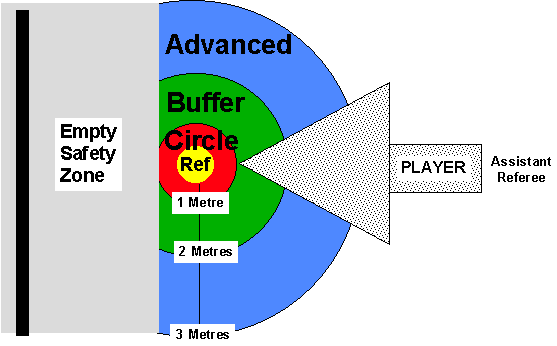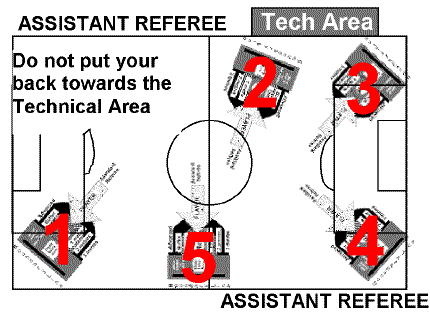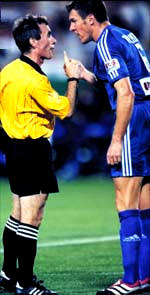| |
 |
A B C’s of CONFLICT
Conflicts on the field of play
Andrew Castiglione
Founder of Ken Aston Referee Society
 |
" The harder you train, the harder it is to quit!!! "
Conflicts on the field of play

This page contains a simple structured method of dealing with conflict on the field of play.
A Referee will need to control conflict on the field of play, in
a constantly structured and safe manner.
This simple method will ensure that the Referee maximizes safety without
having to lessen their control and view of the players. There is much
written on the subject of conflict – but I aim to keep this method as
simple as possible to allow the Referee an understanding on how to
protect themselves, how to position themselves, and how to shepherd all
the players involved into positions where the Referee can manage the
conflict whilst maximizing the control and visibility of all of the
players.
The ABC of Conflict method in the above diagram can be used when the
Referee is disciplining a single player, or when he is being confronted
by a melee of players. The following advises the procedures to be taken
by you (the Referee) when implementing the ABC Conflict method.
Read through the listing below first - and then the diagram above will
make more sense!
1. As soon as a conflict materializes, look around for the best
position, for you to have the perpetrator(s) in front of you - at the
same time as being able to view most of the remaining players on the
field of play. This may mean shifting your position to entice
troublemakers into a position that suits you and not them. A conflict
can be anything from cautioning a player, to dealing with an irate melee
of approaching players.
2. Manipulate the perpetrator(s)so that they are between you and one of
your Assistant Referee. This allows both the Referee and the Assistant
Referee to keep the trouble/conflict area in view and between them at
all times - (and for the Assistant Referee to make a note of the
perpetrator's number). Do not turn your back on the trouble area whilst
you are moving to this position.
3. Try and move into a position where you have your back to one of the
boundary lines on the field of play. This allows you to have a panoramic
view of the remaining players whilst you deal with the culprit(s). If a
boundary line is too far off, move to a position where you have your
back to the part of the field of play that has the least players in.
This way, you can at keep an eye on most of the other players.
One obvious exception – .
4. Once you have decided where to position yourself, call the
perpetrator(s) over to you. (You will not need to call a melee of
players over to you. If the melee consists of players fighting amongst
themselves - position you slightly back from the melee, and observe
closely. As above - try and get your back to one of the boundary lines,
and have the melee between you and you’re nearest Assistant Referee. Try
and have an empty safety zone behind you (look at the above diagram).
There are two reasons for this:
 -
(a) So you don't have to worry about being attacked or abused unseen
from behind.
-
(a) So you don't have to worry about being attacked or abused unseen
from behind.
 -
(b) So that you have a ‘back-off’ and retreat zone should things get out
of hand.
-
(b) So that you have a ‘back-off’ and retreat zone should things get out
of hand.
5. Calling players to you:
There are several methods of doing this, and you can use any method you
like. Some Referees like to make a stand and insist that players do the
'walking'. In other words, the Referee will stand still and beckon the
perpetrator towards him. Some Referees like to approach the perpetrators
themselves (but do not do this if the culprit is purposefully making his
way from you as a gesture of defiance. If this happens - stand your
ground and call/whistle for the player to come to you. Do not chase
players around the field of play. Some Referees like to use a mixture of
the two preceding methods - for example, call the player over, and
whilst the player is making his way towards you, meet him halfway. This
method is probably the best one to use during a game where the Referee
has not had too much trouble to contend. Use whichever method you like -
or use all three during a match depending on the circumstances. If a
game is beginning to get out of hand - always use the first method, and
insist that the players come to you - this gives the players a moment or
two to drop down a degree or two in their temper heat level - before
they get to you. Give players a few moments to blow off a bit of steam,
but don't let them lecture you.
Say to any verbally 'steaming' players:
"I didn't call you over so that you could give ME a lecture".
6. Once you have positioned yourself correctly and the approaching
player(s) are making their way towards you - this is when you need to
gauge how angry they are. This is not difficult - as the facial
expressions, body language and expletives will give the 'game away'.
7. Now this is the most important bit: Make sure you leave a protection
zone between yourself and the perpetrator(s). Look at the above diagram.
The Referee stands in the middle (WHITE/CLEAR) circle. The perpetrator
must NOT come into the 1-meter protection (GREY) circle zone surrounding
the Referee. Keep the perpetrator(s) at least at an arm's length away.
That way, if a punch is thrown, you will at least have some time to
react. Sometimes, very irate players will approach the Referee and stand
face to face with the Referee in an intimidating fashion. This is
commonly known as 'eyeballing' and can be done by players of all ages.
'Eyeballing' is a threat and can be deemed as an offensive gesture under
the auspices of Law 12 Fouls and Misconduct.
When this happens, you have two options:
 -
(a) Say to the player "If you don't take a step back immediately I have
no option but to send you off the field of play for an offensive
gesture". That usually does the trick. It can be argued that the
'eyeballing' threat is ‘Violent Conduct’ - I go some way along with this
argument. (And have been very close to sending players off for this
'eyeballing' threat on a number of occasions).
-
(a) Say to the player "If you don't take a step back immediately I have
no option but to send you off the field of play for an offensive
gesture". That usually does the trick. It can be argued that the
'eyeballing' threat is ‘Violent Conduct’ - I go some way along with this
argument. (And have been very close to sending players off for this
'eyeballing' threat on a number of occasions).
 -
(b) Take a quick step backwards and ask the perpetrator to, "please
don't come any closer".
-
(b) Take a quick step backwards and ask the perpetrator to, "please
don't come any closer".
8. If you anticipate that the perpetrator(s) is approaching you in a
manner that suggests that he will take some stopping as he approaches
you. Tell him to "calm down", "slow down", "keep a distance away" or any
other verbal warning that you can think of to that effect. Do not put
the whistle to your mouth (unless you want to lose more teeth than is
necessary under the circumstances). At the same time, use your 'body
language' by holding out both of your hands palms forward (like shooing
cows back) and gesture at them to slow down and demonstrate this by
shooing the cows (sorry players) back. Do not stand still at first when
you are doing this, else you are likely to get stampeded. Use a bit of
Law 18 Common sense, and gain a few extra moments by moving backwards a
few steps whilst making the warning actions just mentioned. Standing
still will be 'like a red' rag to Bull'. Do not take too many steps
backwards, because there comes a moment when you have to make a stand
and show the perpetrator(s) that you are in charge and will not be
intimidated. When you reach this moment - 'stick to your guns' - stand
firm and erect, and take any necessary action that ensues should players
ignore your aforementioned warnings. Another trick (should you be near
to one of the boundary lines) is to step off the field of play, and warn
approaching players that anyone leaving the field of play will be
cautioned (for leaving the field of play without your permission (see
Law 12)). If they do step over the boundary, then award them with a
yellow card! This method is particularly useful when you have given a
penalty that is not to the liking of one team! If players look as though
they are about to murder you - just back off over the goal line and give
them the same warning - it usually works a treat - and at least then,
you only have to worry about a manslaughter charge instead of murder!
9. Look at the DOTTED (2 meter circle) in the diagram above. This is the
position that you want the perpetrator to stand whilst you are
admonishing him/them within a minimum of between 1 meter and 2 meters
away from you. Attempt to get the player to approach you so as you have
your nearest Assistant Referee in sight in the background. This cannot
always be achieved, but keep this in mind. It is surprisingly easy to
maneuver players around to achieve this effect - and they don't even
know that you have done this.
10: Now we get to the big striped circle. This is my favorite circle -
because this is the exclusion zone circle for ALL other players that are
not part of your disciplining equation. In other words, when you caution
or send-off a player, whilst you are taking his particulars, shoo away
all the other players who want to get involved. Including the Team
Captain who (although he has ignored all your previous pleas for help
during and before the game) suddenly decides that his responsibility has
now peaked and that he is the perpetrator’s Lawyer. In my experience, it
is difficult enough dealing with one player - it becomes doubly
difficult if another player muscles his way into the dotted (or striped)
circle. I have tried many methods of dealing with confrontations - my
advice is to strongly wave away players that are not part of your
disciplinary action. Tell them in no uncertain terms to
.
Keeping them well away creates a large safety zone for you to work in.
It also prevents so called 'team-mates' misconstruing your words spoken
to the perpetrator(s). If you need to speak to the captain, do so after
you have dealt with the perpetrator(s).
"KEEP ALL OTHER PLAYERS THAT ARE NOT INVOLVED...
- OUTSIDE OF THE
STRIPED CIRCLE,
AT LEAST THREE METRES AND MORE
AWAY FROM YOU WHEN YOU
DEAL WITH MISCONDUCT."
11.When confronting irate players give them a few moments to calm down.
Ask them to calm down as they approach you. Walk a few more steps
backwards as they approach you - this allows a few more gasps of steam
to be released.
Most players do appreciate a few moments of 'time out’ to allow their
tempers to cool down a degree or two. I use this delaying confrontation
method many times during a game to good effect. Always be polite but
stern with players when you are disciplining them. Try and remain calm
on the outside, even if you are jelly on the inside.
12. To summarize:
 - White/clear circle = position yourself here to maximize your control
of the match at the same time as dealing with discipline. Keep a clear
retreat safety zone behind you if you can. Aim to have your back to one
of the boundary lines if you can.
- White/clear circle = position yourself here to maximize your control
of the match at the same time as dealing with discipline. Keep a clear
retreat safety zone behind you if you can. Aim to have your back to one
of the boundary lines if you can.
 - Grey circle = 1 meter Referees protection zone. Do not let players
enter this (eyeballing) zone.
- Grey circle = 1 meter Referees protection zone. Do not let players
enter this (eyeballing) zone.
 - Dotted circle = this is where the perpetrators should be standing
whilst you discipline them, or when you want to give them a "talking
to".
- Dotted circle = this is where the perpetrators should be standing
whilst you discipline them, or when you want to give them a "talking
to".
 - Striped circle (my favorite) = the 'shoo away' zone. Keep clear of all
other players - especially the ones with good hearing and the 'so called
captains!
- Striped circle (my favorite) = the 'shoo away' zone. Keep clear of all
other players - especially the ones with good hearing and the 'so called
captains!
 - Manipulate the perpetrator so that he approaches you in the direction
shown by the big 'PLAYER' arrow.
- Manipulate the perpetrator so that he approaches you in the direction
shown by the big 'PLAYER' arrow.
 - Keep your nearest Assistant Referee in the background behind the
approaching player as shown in the diagrams.
- Keep your nearest Assistant Referee in the background behind the
approaching player as shown in the diagrams.
 - Keep calm and always be polite to players (even though you feel like
Hell)
- Keep calm and always be polite to players (even though you feel like
Hell)

The above diagram shows typical positions that can be used on the field of play.
PLACE YOUR BACK TOWARDS THE TECHNICAL AREA.
(Position 2 above)
The ABC method of dealing with conflict has been used to good effect by
me for many years. There will be times when you will not be able to use
this method (for example – when a situation develops very quickly and
calls for you (the Referee) to take instant action. Nevertheless, the
method is a structured way to approach conflict, and can be used to
advise new (and experienced) Referees on a structured way to deal with
conflict on the field of play.
The ABC Conflict method is my own opinion and is not sanctioned by or
affiliated with any governing body of football/soccer. Reference to the
male gender on this page with respect to Referees and Assistant Referees
are for simplification only and apply to both males and females.
MANAGING SERIOUS SITUATIONS

1. In the business world there are a myriad of courses available to help
you develop and improve your man management. Unless you are fortunate
enough to be able to attend these through you primary employment then as
a Referee you have to be self-motivated to develop these skills.
In-service training, the Referees Association and League Official
Associations can assist with your development. It was during a recent
seminar that I was stimulated to write this article.
2. Serious situations can occur in any game, fortunately they tend to be
infrequent but they can be unexpected and will develop even further if
you are not properly prepared to deal with them.
3. So what is a Serious Situation? - A significant confrontation between
two or more players involving (handbags), violent pushing, fist fighting
or head butting etc. During the Potential Referees Course and in-service
training an attempt will be made to provide advice but nothing can
prepare you for the very first Serious Situation. Do you have the
necessary skills to handle these situations as fighting between players
are not a normal part of the game. Consider the following practical
pointers if you ever find yourself in this situation.
4. There are 3 areas that can be considered, these are:
 - Before the situation
- Before the situation
 - During the situation
- During the situation
 - After the situation
- After the situation
Before the Confrontation
5. Usually a Serious Situation does not occur "out of the blue". Like
major thunderstorms there are normally warning signs prior to the actual
event. You, therefore, must always be aware of the atmosphere of your
game. If the temperature in your game is rising, you must keep your cool
and composure. To maintain your control or to get the game back,
consider penalizing all offences for the next 5 or 10 minutes, firmly
and with confidence. Hopefully, this will have the effect of breaking
the chain of events that has put the game into this state. You may
certainly take some questioning/dissent for all the sudden change in
attitude in that you penalize anything that moves, however, this may be
better than letting the players take justice into their own hands.
6. Try to slow the game down and do not apply the advantage clause. Slow
down the restarts; take time at substitutions or writing information in
your book, etc. Hopefully, this will slow down the frantic pace and
allow the players to get back to concentrating on playing the game,
rather than getting at opponents. This may go against good advice that
you may have been given - getting on with the game because if the
players are playing the game they are unlikely to be showing dissent
towards you. This advice although good is not relevant in this
situation.
During the Confrontation
7. Anticipate the confrontation before it happens. Sprint to the
incident and use your voice to prevent the player’s actions from
escalating. Your presence and positively taking charge of the situation
at this point is critical. Perhaps your anticipation was wrong and you
won’t need to act further, however, if you are right, you will be on top
of the players in an instant, which is where you need and want to be.
8. So if your anticipation was correct and now you have two players
"going at it". Slow down as you approach the players; use your voice and
strong, loud, long blasts on your whistle, possibly followed by a series
of short, but loud blasts on the whistle. This is intended to have two
effects. First of all, it shows all others (players, the benches, the
spectators) that you have seen it and are taking action and it may snap
the players involved out of their ‘red mist’ confrontation. Try to take
the attention away from the players and direct it to yourself by your
actions.
9. Take charge and try to separate the players, but be aware that if you
raise the level/tone of your voice it may sound to others as though you
are angry, so it may be better to use your whistle at this point.
Adrenaline, pheromones and all other sorts of chemicals are now driving
normally peaceful people into raging tempests and your reactions can
also be affected. Hopefully, your actions up to this point will have
convinced other players that you are in control of the situation,
however, do not let your guard down. Sometimes the third player arriving
at the confrontation may sometimes inflame the situation or carry out an
act of violent conduct. Keep your head up and position yourself to see
if anyone is approaching the incident. You may have to temporarily take
your focus off the two combatants to the approaching third player. You
must do everything to prevent this individual from getting involved.
10. Expect other players to congregate around the incident. They,
however, often arrive on the scene to pull their team mate away and/or
calm the altercation down, so use this help if it is available, ensuring
excessive force is not used.
11. When dealing with the confrontation there are contrasting options
these are:
 - a. It may be possible for you to position your body between the
players to form a barrier and de-fuse the situation. Always ensure that
you avoid direct physical contact by touching or handling a player, the
player may take exception to your actions.
- a. It may be possible for you to position your body between the
players to form a barrier and de-fuse the situation. Always ensure that
you avoid direct physical contact by touching or handling a player, the
player may take exception to your actions.
 - b. This action whilst a positive step is fraught with danger and is
not recommended as it does restrict your view masking arriving players.
It is strongly suggested that you should never step between players in a
confrontational situation as they may strike you accidentally or as a
reaction to your ‘push’. Either outcome will lead to a more serious
situation with a possible cause to abandon the game.
- b. This action whilst a positive step is fraught with danger and is
not recommended as it does restrict your view masking arriving players.
It is strongly suggested that you should never step between players in a
confrontational situation as they may strike you accidentally or as a
reaction to your ‘push’. Either outcome will lead to a more serious
situation with a possible cause to abandon the game.
12. Match control may be regained by Cautioning/Sending off offenders as
quickly as possible. You will again be sending the message that you are
in charge and in control. If you wait, you risk losing a crucial moment
to impact the players on the field, which may lead to more players
becoming involved. There is the potential that further Cautions/Sending
Offs may be required as a result of consultation with your Assistants.
13. Alternatively, whilst ensuring the players are separated you take
the time to allow the situation to cool whilst consulting with your
Assistants to confirm your next actions ensuring that all guilty players
are punished.
14. When dismissing a player from each team it is essential that you
leave sufficient time between the procedures to ensure that the players
leave the field separately, there by reducing the risk of an additional
confrontation. Some consider that you should always send off the away
team player first as the home crowd will cheer and celebrate with joy
and may not notice that you have also sent off their player. The other
option is to send off the away team player last – leaving the home crowd
cheering.
15. Always ensure that players sent off have left the playing area.
After the altercation
16. Ensure all the "little fires" are out before restarting the game.
With players from both teams milling around, there is always the
potential for other altercations.
Before restarting play, be sure to check with each Assistant Referee, if
you haven’t already done so as they may have seen something missed by
you.
17. If you have not dealt with the situation correctly or the players
consider your action to be inadequate there may be the possibility of
retaliation or retribution. Your concentration should be focused on this
possibility.
18. Finally, ensure the incident is reported to the appropriate
authorities as factually as possible (request that your AR’s submit
reports).
|